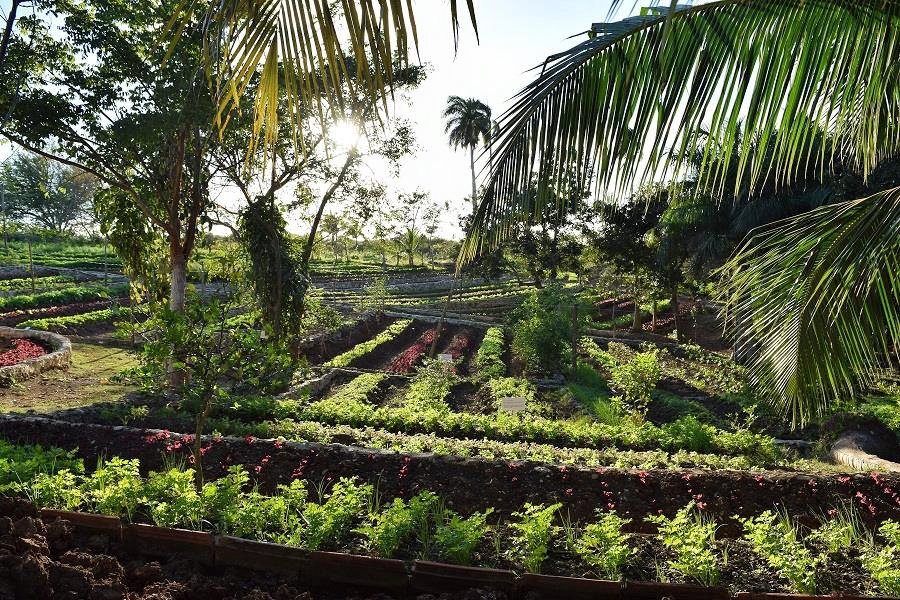Late last year, not long after then president Barack Obama reduced trade restrictions with Cuba, the chance to explore the state of sustainable agriculture in Cuba became an opportunity I did not want to miss. In early February, I was introduced to a world I knew existed but found hard to fathom fairly from the perspective of my upbringing. I had arrived on an organic Caribbean island, spurned across the globe, striving to find its own way forward while just 90 miles off the coast of the world’s largest economy.
Cuba has become a buzzword in the West for all that is wrong with economic systems. Although largely stemming from the Red Scare of the 1930s, the resulting cultural fear of a political system in opposition to capitalism and much of the American way of life permeates foreign diplomacy with this small nation of 11 million. And yet, in communist Cuba nobody starves, local food is organic food, and the availability of medical care ensures a healthy populace focused on preventative health and self-reliance. And as I came to see up close, changing leadership is making way for more capitalistic farming systems.
La Revolución Verde
Cubans might not have planned their green revolution, but in the early 1990s the economic collapse of Russia, Cuba’s primary trading partner, necessitated it. Facing food shortages, Cuba became a nation focused on growing food—but without access to the tools of industrialized agriculture: imported fertilizers, pesticides, machinery and petroleum. This created a nation of highly experienced organic farmers with a wealth of insight to share. If we brush aside the cloud of communism that hovers over Cuba, we can glean rare insight into sustainable growing from people who have harnessed the power of permaculture for decades.
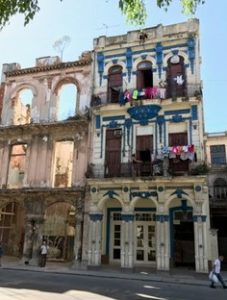 My first impressions of Cuba were a mixed bag. I had expected to see poverty and poor housing conditions, but was surprised at the deterioration of the cityscape; the letting go of beautiful colonial architecture in want of the equipment and materials to fix it. Cuba, a land that encourages the arts and the artists, appeared to invest more in its people than its places. Stifled by the rate of urban decay everywhere I looked, I had to wonder just how well this green revolution was going.
My first impressions of Cuba were a mixed bag. I had expected to see poverty and poor housing conditions, but was surprised at the deterioration of the cityscape; the letting go of beautiful colonial architecture in want of the equipment and materials to fix it. Cuba, a land that encourages the arts and the artists, appeared to invest more in its people than its places. Stifled by the rate of urban decay everywhere I looked, I had to wonder just how well this green revolution was going.
During our week-long stay, we visited several farming operations in and around Havana, Cuba’s capital city. It was in Havana that Fidel Castro and Che Guevara declared a socialist revolution of the people in 1959, having ousted a far-right authoritarian government headed by Fulgencio Batista who had cancelled the last general election. Castro ruled without much competition for five decades, stretching the definition of socialism to its broadest edges.
The impact was evident even on the drive from the airport, given colorful narration by our guide. Cuba has the highest divorce rate in Latin America, but the lack of housing means that most couples remain under the same roof after they split. Much of the building stock itself was depressing, a Brutalist architectural vestige of the Soviet era which locals wryly call by name now that Cuba’s love affair with Russia is over.
Our guide took particular pleasure in explaining license plate symbols denoting whether a vehicle is owned privately or by the state. Very few Cubans own vehicles, and those who do may pay as much as $40,000 USD for an almendrón—those impossibly old classic cars as hard to destroy as an almond kernel, which gives them their name. Who exactly is paying this kind of money was unclear when we learned that the wage paid by the state is just $20-$30 USD per month, even for doctors. (Not surprisingly, one of the top Cuban exports is its skilled medical workers.) Distribution of vehicles, as with all imports, is tightly controlled by the state. The newer and nicer vehicles were military and governmental, signaling to me the nature of the haves and have-nots on this egalitarian island.
After a visit to Revolution Square and the Museum of the Revolution, we stopped for lunch at an oceanside paladar—a residence converted into a restaurant, one of a new class of privately-owned businesses in Cuba. Here, as we would experience throughout the trip, we were in a beautiful setting being served a wonderful meal, mostly of Cuban staples. Yet each meal reflected the nation’s isolation. There was little experimentation in the cuisine (although this is changing as chefs have begun to travel abroad), and the fresh foods we enjoyed were rare and special, just for tourists.
Discovering Diversified Crop Production
Since Cuba’s political revolution, citizens have maintained a basic caloric intake using food ration cards that ensure equal distribution of food across the populace. But with food shortages from trade embargoes and the decline of partner nations around the world, Cuba has had to seek solutions from within its own borders. Without industrial machinery, heavy equipment, often basic construction materials, petrochemicals for fertilizers and pesticides, nor oil to fuel transportation, the farmers of Cuba found themselves in a position where organic permaculture—encouraging diversified crops to reduce pests and increase yields—was the only way forward. So it was that when food supplies were tight, the organic farming industry of Cuba saved a nation from starving.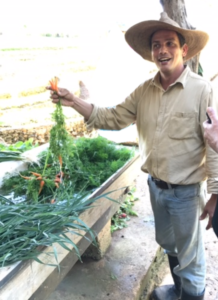
Out of three farms we visited, two were attached to private restaurants and obviously focused on ecotourism, while a third, Finca Marta, was a family farm quite literally grown from the roots up. Owned by Fernando Funes, Finca Marta is a 16 acre farm that produces 60 varieties of fresh produce employing a variety of sustainable agriculture techniques. The farm features natural barriers that frame raised beds, terraced planting to reduce run off and maximize space, a biodigester converting working animal waste, interspecies planting, and an apiary with 100 hives.
We enjoyed a taste of this honey as Funes explained how the Finca Marta project began. The property was made available as part of a massive farmland distribution program that began in 2008 to boost production at a time when large state-controlled farms were incurring losses—partly due to wage controls that offered no incentive to improve efficiency—while small private farms were proving to be more productive. The state made more than 3.7 million acres available to 180,000 new private farmers. But the program did not have the desired impact because the government was not able to provide other supports such as housing and equipment, so many young farmers returned to the cities.
After completing a PhD on restructuring farming systems in Cuba, Funes was ready to put his agroecological ideas into practice despite these challenges. At Finca Marta, Funes studies the interactions among farming, the environment and society in a project he calls “Farming Like We’re Here to Stay.”
“The Well is the Metaphor”
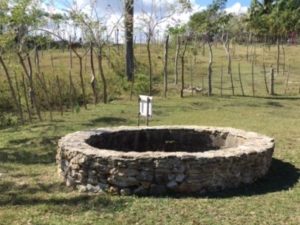 If you have heard anything about Finca Marta, it is likely to be the well: 46 feet hand-dug and seven months in the making. For Funes, the well became the metaphor for the difficult transformation he hoped to bring about, both in farming and in people’s attitudes.
If you have heard anything about Finca Marta, it is likely to be the well: 46 feet hand-dug and seven months in the making. For Funes, the well became the metaphor for the difficult transformation he hoped to bring about, both in farming and in people’s attitudes.
He faced many challenges. At first it was the will of people to work hard on the land when almost any other job was an easier way to earn an equivalent wage. He eventually learned that you can get workers if you pay well. Now, salary is based on what is produced, which amounts to higher than the average governmental wage even after paying tax and social security.
Then it was the lack of resources allocated to smaller farms, requiring him to tailor the farming systems to local conditions. Sloped terrain was shaped into raised beds, using thousands of rocks removed from the soil, and it inspired the gravity-fed design of the biodigester. An abundance of flowers became the feedstock for the apiary, which now produces four tons of honey each year. And the lack of water forced the digging of a well by hand—yet that well gave Funes a close relationship to the land, and to the surrounding community that came curious to learn what an academic researcher was doing at the bottom of a 14 meter pit.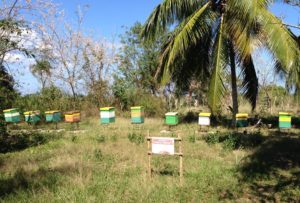
Today’s challenges are the lack of opportunities to connect to other countries for export—Funes grows three hectares of high quality organic arugula that could be packed on the farm and exported if the markets were available to him—and more rapidly spreading the knowledge that his experiment is gaining.
Even so, economic and social conditions have improved within his community as the transformation takes root, employing strategies commonly used by farm and food businesses here in the States. He keeps post-harvest losses low and prices high through direct sales to 100 restaurants in Havana. This provides enough profit to reinvest in farm improvements and pay higher wages to their 20 employees. This year they began a CSA, growing organic food for the community and selling it at about half the price charged to restaurants.
A Tale of Two Systems
As he brought his story to a conclusion, Funes drew the obvious comparison. In the U.S., we are experimenting with social enterprise models to address the inequalities and negative externalities brought about by our capitalistic food system. At Finca Marta, they are experimenting with a capitalistic farming model to address the inefficiencies, falling productivity and weak investment brought about by their socialistic system.
And how does the government view this? Favorably, it seems. Last year before his death, Fidel Castro visited Finca Marta, and liked what he saw. He left Funes with three directives:
- Anything that improves people’s lives, and is legal, I am for.
- I want you to stay here and expand.
- Let’s do a project together.
Since that visit, Finca Marta has received a gas powered tractor and its staff is incubating five more small farms, exchanging knowledge and spreading Funes’ farming philosophy. While each farm will remain independent, Funes’ approach is to spur profitable growth through coordinated commercialization, and promoting agritourism throughout the territory including its coastal lands. Following Fidel’s dictate, he envisions the territorial plan being used as a starting point for communities in other regions to “farm like they are here to stay,” and over time transform the Cuban countryside.
Enjoying a favorable relationship with the government, Funes has traveled far sharing his agricultural ideas and sees an opportunity to distribute them more broadly. He has launched a Gofundme campaign to produce a book about the Cuban agricultural system and the Finca Marta story, with the hope that it can lead to “an ecological, socially equitable and healthy worldwide food system.”
Finding the Balance
Since the privatization of Cuba’s restaurant industry, the demand for local food has risen in tandem with the growing agritourism sector, rerouting fresh food to the cities’ paladars and hotels and affecting food supplies for citizens. Yet, agritourism has helped foster stronger ties between American and Cuban farmers, instigating useful dialog that could help increase sustainable food production in the long term and thus improve the lives of millions.
You might view Cuba as a socialist paradise, or you might view Cuba as an impoverished communist wasteland. Neither is true. Cuba is agriculturally and culturally rich, but at the same time, has a society that offers weak encouragement and little reward for ambition, entrepreneurship and investment. So I am left with two questions. How can a country like the United States learn from and adopt some of Cuba’s most progressive agroecological practices while retaining the positive incentives of capitalism? And could foreign investment in Cuba, credit for Cuban exporters and a steady injection of U.S. funding into this neighbor and potential trading partner be the capitalist nudge necessary to help Cuba make the most of its natural resources, its land and its people?
In a poll last year, millennials in the U.S. were found to view socialism more favorably than capitalism. To me this sounds a warning. Socialism may appear to be the answer to justifiable concerns about inequality in America, but I would not point to Cuba for answers. Yes, everyone has just enough to get by, but to my eyes not enough to thrive. The evidence goes beyond the obvious lacks in housing, transportation and food. The steady migration of young people seeking a better life, the government favoring insiders in distributing imports and other limited resources, and the absence of a free press make it hard for me to believe that their brand of socialism is enough to raise the human spirit.
It is fair to say my time in Cuba was brief, a highlight reel of a world I am only just beginning to understand. But the impact of those seven days will linger as I continue to work in the tense spaces between big and small food, sustainable and conventional agriculture, and capitalistic and socialistic ideals.
A food system at this nexus is just 90 miles from the coast of Florida. If you ever have the chance to visit Cuba, I hope you take it.
(Cover Photo from Finca Marta)

